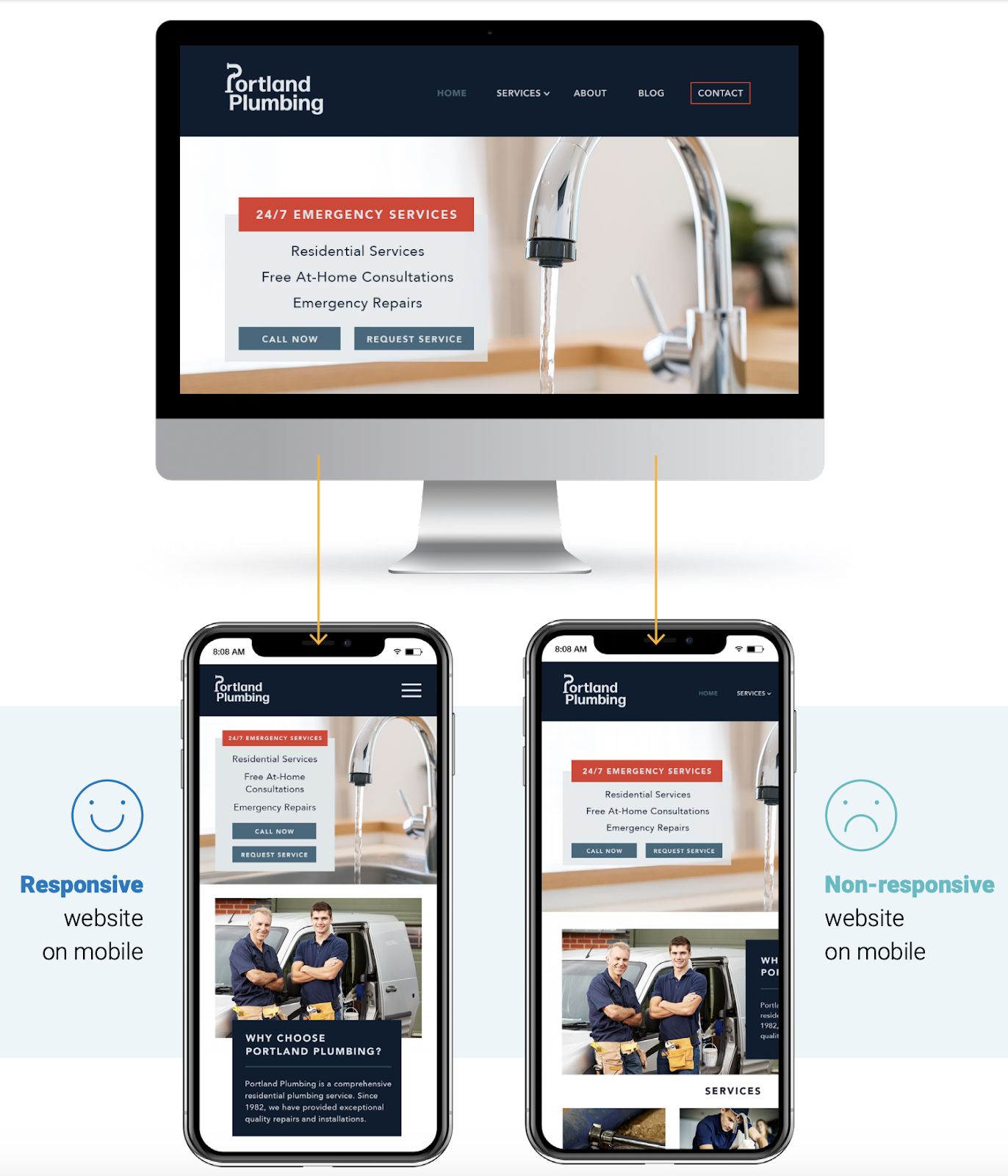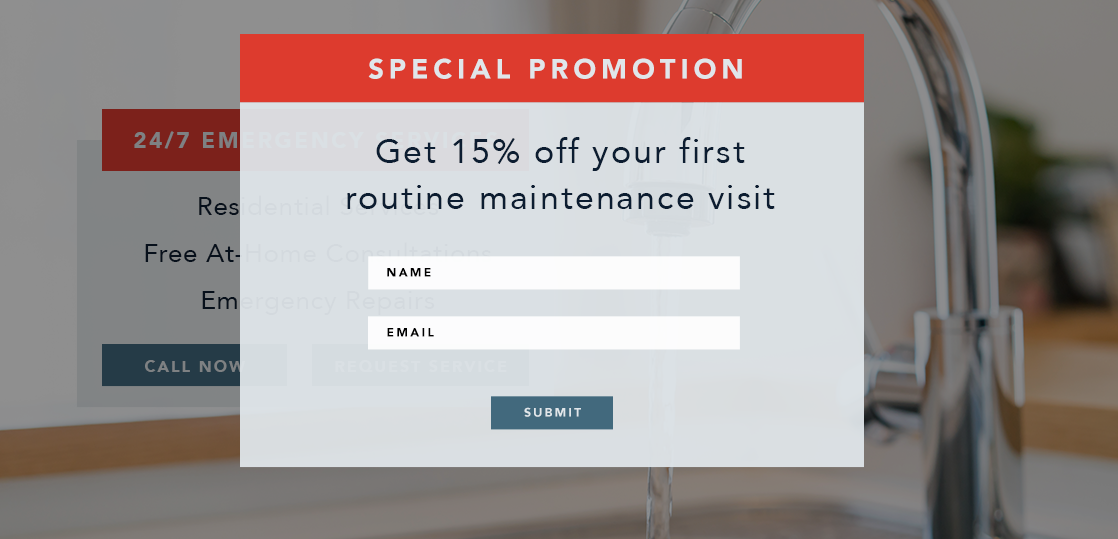
Many home services contractors feel frustrated because they’re not getting the number of leads they want. For others, the problem is much more critical: They’re not getting the number of leads they need, and their business is in jeopardy.
If that sounds familiar, there’s a fair chance your contractor or construction business website has something to do with it.
As I’ve mentioned before, as many as 97 out of 100 people go online to learn about local businesses. That means if people aren’t finding your website, or if your website isn’t helpful to them, you’re missing leads.
Today, we’re going to focus on that second bit: How to create a helpful website so people will want to hire you. (I’ll get back to the “how to get found” question soon enough. Promise.)
Four keys to an effective construction website or general contractor website
I get that you’re likely not a web design and development guru, so trying to figure out how to get more customers online might feel daunting. I’m going to let you in on a little secret: Building a great home services website doesn’t have to be complicated. In fact, I recommend keeping things simple so you don’t get bogged down by difficult-to-maintain features and unnecessarily fancy design.
Stick to the following basics, and your business will grow.
1. Make sure your home improvement website is mobile-friendly
According to research, more than half of all internet traffic is happening on mobile devices, and it’s estimated that mobile data traffic will increase by seven times between 2017 and 2022. What does that mean for you? More and more of your leads are looking for your help from their mobile devices, so if your website only works well on a full-size screen, they won’t bother with it. Or you.
By contrast, a mobile-friendly website is designed in such a way that people can read and navigate your site with ease—regardless of the device they’re using.
How can you tell if your current website is mobile-responsive? Pull up your site on your cell phone:
- Is the navigation menu always visible?
- Is the text legible without pinching and dragging to enlarge it?
- Is there sufficient space between buttons and links—so you can press one without pressing another?
- Can you read the entire page without scrolling left and right?
If you answered yes to those questions, your site is likely set up for mobile devices. If not, updating your site should be your top marketing priority.

By the way, because people care so much about mobile-responsiveness, Google does, too. Since April 2015, the search giant has been rewarding mobile-friendly sites in their rankings—and penalizing those that aren’t.
Let’s get super practical about what that means: If your competitors’ sites are mobile-responsive and yours isn’t, they will very likely show up higher than you on the search engine results page (SERP). That matters because, on average, moving up one spot on the SERP means a nearly 31% increase in click-through rate. Whoa. To see if Google views your site as a mobile-friendly, use their free tool.
2. Offer great content on your home improvement website
When people visit your home services website, they’re looking for answers to their questions and solutions to their problems. To serve them well, you’ll need to be intentional about the content you provide and how you organize it. The following pages are must-haves.
Homepage
Your website homepage is the virtual front door of your business and, on average, you have 15 seconds to convince people they’re in the right place. Your home page should answer five questions—quickly:
- What service(s) do you offer? Be clear, specific, and brief. You can go into detail on your Services page.
- Who are your services for? Do you only serve commercial clients, or are you open to residential jobs?
- So what? Without criticizing your competitors, let people know why they should choose you instead. What unique value do you bring to your customers?
- Why should people trust you? Include a couple of reviews, testimonials, and/or logos from companies you’ve served. (People don’t care what you say about you; they care what other people say about you.)
- What should site visitors do next? Make it ridiculously easy for people to do business with you by including a clear call to action: schedule a call, make an appointment, and so on.
Services Page
When you’re trying to develop content for your website, the easiest way to start is by thinking about what questions your customers are asking — and then answering them. For your services page, those questions are:
- What services do you offer? Provide more detail than you did on the home page, but don’t go overboard. Also, be sure to use clear and simple language, not industry jargon.
- What problems do you solve? This might seem like the same thing as services, but it’s not. For example, “hydro-jetting” is a service that solves the problem of sewage backing up into the shower.
- What’s your service area? List all the communities you serve. If you’re in a metropolitan area, customers will need to know if you’re willing to travel from the far corner all the way to the opposite corner.
About Page
Most businesses waste real estate on their About page talking about how their company got started and offering way too much detail about their team. Most customers don’t care about that; instead, they want to know if you understand what they need or want, and if you’re qualified to provide a solution. Address those concerns on your About page.
Blog Page
Posting regular updates to a blog is a highly effective way to display your authority as a home services or construction professional. Most general contractors feel overwhelmed trying to come up with ideas to blog about, so here’s a tip: Have each of your team members brainstorm the top 10 questions they hear from customers, write out the answers, and post each response as a blog post. (Yes, it’s really that simple.)
Contact Page
Your Contact page should include very little text. Here’s what you want it to have:
- Phone number
- Email address
- Physical location/showroom if you have one
- Map of your service area
- Links to your social media channels
- Hours of operation
- Contact form (Be sure to test it regularly to make sure messages are coming through!)
- Automated chat feature
3. Use attractive imagery on your home improvement website
Images on your construction website or contractor website should be high-quality. Although original photography is preferable, you can find affordable (often free!) images through stock photography sites like Unsplash and Envato Elements. Be sure to use images legally; don’t just snag a random photo from Google.
Be intentional with your photos. For example:
- Home page – Show what success looks like for someone who uses your services.
- Services page – Show a friendly member of your team interacting with a customer.
- About page – Use images that help people imagine what it would be like to work with you — shots of your friendly and professional-looking team in action are great choices.
- Blog page – People get overwhelmed when they see too much text on a page, so break up lengthy blog posts with a relevant image or two.
- Contact page – Include a photo of your physical location — especially if it’s not in an obvious place — and be sure to include a map.
4. Capture leads from your home improvement website
What happens if someone visits your website and doesn’t schedule a consultation or service call right away? It’s unlikely they’ll come back again. But if you have a way to contact them, you can nurture them toward a sale.
The best way to capture these leads is to collect email addresses, and you can do that by adding email sign-up forms to your site. Offer something of value to your website visitors in exchange for their email addresses — like a discount or a DIY repair guide — to get more people joining your list.
Once you have someone’s email address, you can reach out on a consistent basis, sharing a combination of helpful and promotional messages to encourage them to do business with you.





